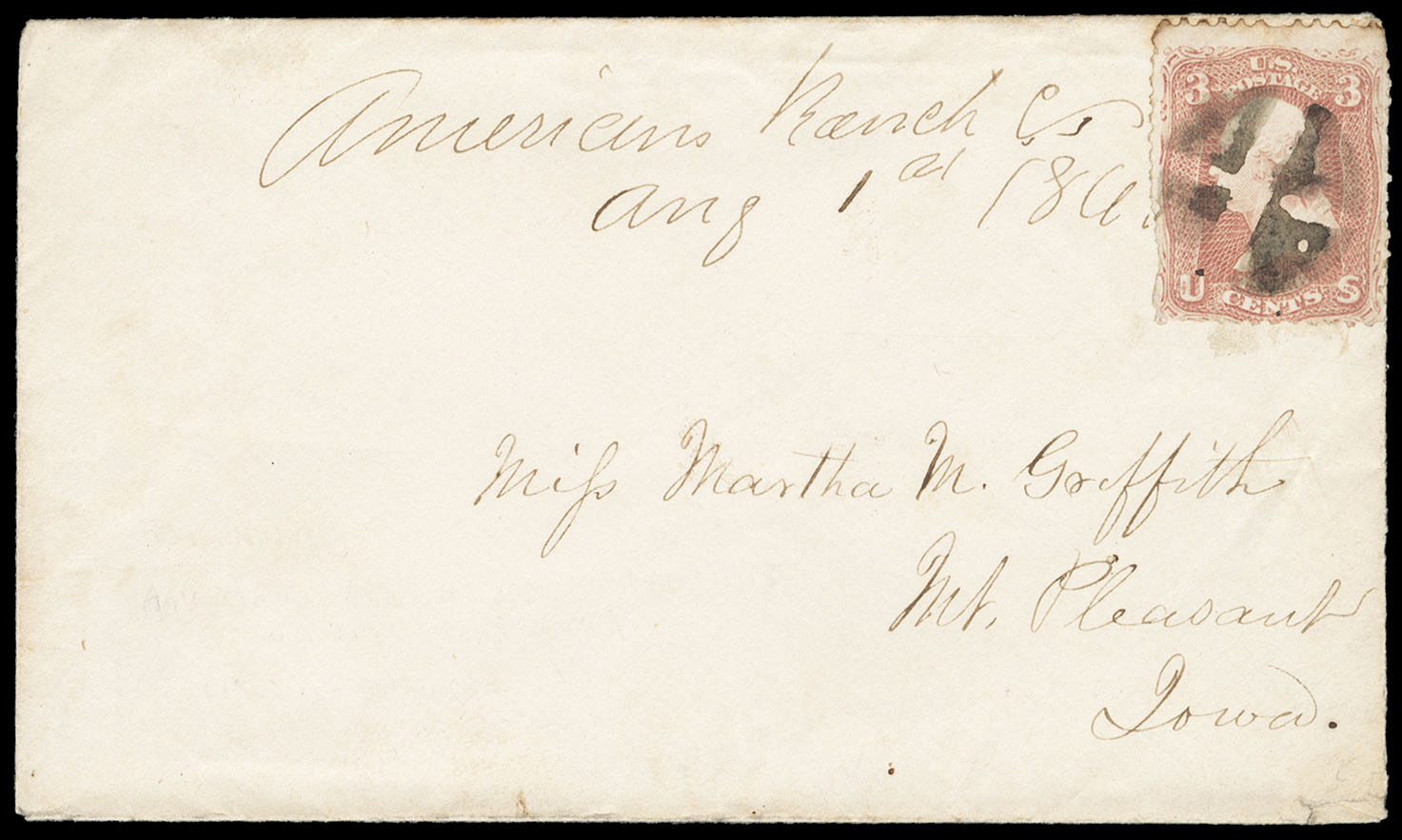
Lot
430 
"American Ranch, C.T., Aug 1st, 1865", manuscript postmark tying 3¢ rose (65), few nibbed and toned perfs, and also tied by additional quartered cork cancel on cover to Mt. Pleasant, Iowa, Very Fine and rare, ex-Bauer. Estimate $1,000 - 1,500.
THE EARLIEST RECORDED MANUSCRIPT POSTMARK FROM AMERICAN RANCH.
The Indian uprisings of 1864 and 1865 interrupted transportation and mail services in old Weld County. The Post Office at American Ranch was closed from December 1864 to the first of May in 1865 due to these uprisings. The stage station and the Post Office were housed in an adobe structure, as were many of the town's other buildings. Many of these buildings had walls two to three feet thick which served as effective fortresses during the Indian raids.
Realized: $2,200

Lot
431 
"Bents Ft., C.T., April 30", circa 1865 manuscript postmark with matching manuscript strokes on 3¢ rose (65), s.e. at left, applied over Official Business imprint on "Paymaster Office, Denver, C.T." corner card cover with "Denver C.T." crossed out, addressed to Denver C.T.; cover reduced at right, otherwise Very Fine, Illustrated in Jarrett's Colorado book, ex-Bauer. Estimate $750 - 1,000.
A RARE MANUSCRIPT POSTMARK FROM BENTS FORT WITH ONLY A FEW KNOWN.
The first gold seekers to reach the junction of Cherry Creek and the South Platte River came by the Santa Fe Trail to Bent's Fort, up the Arkansas River Valley, then north over the divide to Cherry Creek. Although the trading post of Bent's Fort was established in 1834, it was nearly thirty years before it obtained official postal service.
Realized: $1,300

Lot
432 
Bent's Fort, Col., Apr 18, bold double-circle datestamp duplexed with circle of wedges on 3¢ red, F. grill (94) on yellow cover to Middlefield, N.Y.; cover slightly reduced at left, Very Fine and choice, ex-Bauer. Estimate $750 - 1,000.
ONE OF THE FINEST OF ONLY THREE RECORDED USAGES OF THE "BENT'S FORT COL." DOUBLE-CIRCLE TERRITORIAL POSTMARK.
Until 1873, Bent's Fort remained an important junction point for trails to Denver and Santa Fe. Then the approaching Santa Fe Railroad began to change travel patterns in the Arkansas Valley.
Realized: $2,400

Lot
433 
Black Hawk Point, Col. T., Feb 27, full bold strike of custom cds on 3¢ pink (U34) entire cancelled by matching targets to New York City; some edge wear, Very Fine, a choice example of this scarce territorial postmark, ex-Bauer. Estimate $200 - 300.
This postmark was used only in early 1864. The postmaster obtained these devices from private suppliers, rather than the Post Office Department in Washington.

Lot
434 
Black Hawk Point, Col., Jan 9, '65, clear double-circle datestamp duplexed with target cancel ties 3¢ rose (65) on cover to New York N.Y., Very Fine and choice, ex-Bauer. Estimate $150 - 200.

Lot
435 
Black Hawk Point, Col., Apr 24, two strikes of cds duplexed with target cancel tying 2¢ black (73) and 10¢ dark green (68a) on 1868 cover to Farnham, England, red New York (5.2) and Liverpool U.S. Packet (5.13) transits, Farnham (5.14) arrival backstamp, forwarded to Chrislehurst, May 14th arrival backstamp; 2¢ restored upper right corner, Very Fine appearance, ex-Sampson. Estimate $750 - 1,000.
A RARE COLORADO TERRITORY TRANSATLANTIC USE TO GREAT BRITAIN.
Realized: $800

Lot
436 
Boulder, C.T., Jun 27, two strikes of forwarding cds on missent cover from Racine, Wis. to Big Thompson, C.T., franked with 3¢ rose (65) tied by target cancels, matching origin cds at center, manuscript "missent" notation, with original 1865 enclosure; cover with vertical fold affecting stamp, otherwise Very Fine, ex-Bauer. Estimate $300 - 400.
Realized: $350

Lot
437 
"Breckinridge C.T., 16th May 1861", manuscript postmark and matching cross-hatch cancels 3¢ dull red (26) on cover to Pecatonica Iowa, original long letter datelined "French Gulch Utah Territory May 12, 1861" from Albert Pillsbury writing to a friend, transcript accompanies; cover reduced slightly at right, F.-V.F. Estimate $500 - 750.
A SCARCE EXAMPLE OF THIS BRECKINRIDGE MANUSCRIPT POSTMARK, THE EARLIEST RECORDED WITH THE "BRECKINRIDGE" SPELLING.
Named for Vice President and presidential candidate John C. Breckinridge, the town later changed its spelling to Breckenridge after its namesake's support of the Confederacy in 1861.

Lot
438 
Breckin Ridge, C.T., Jun 27, dark blue corrected cds (Breckinbridge with offending letter "B" chiseled out) and matching target cancel tie 3¢ rose (65), corner crease, on Wm. P. Pollock, Notary Public and Conveyancer corner card cover to Georgetown Col.; minor cover edge restoration, Very Fine appearance, a rare early example of this corrected cds. Estimate $500 - 750.
This corrected date stamp enjoyed a long service. In later years, as it wore down, traces of the "B" began to re-appear.
Realized: $450

Lot
439 
"Canon City, C.T., Aug 30th", manuscript postmark with matching squiggle cancels 3¢ dull red (26) on yellow 1861 cover to Barnard Vt.; repaired lower left corner, Very Fine appearance, The earliest recorded postmark from Canon City, the Jarrett listing example., ex-Bauer. Estimate $200 - 300.
At the entrance to the Royal Gorge of the Arkansas, Canon City became a transportation and supply center for the surrounding territory. It was the only post office in that part of Utah Territory which became part of Colorado. This office was established in Kansas Territory December 13, 1860 and transferred to Colorado Territory in 1861.
Realized: $300
